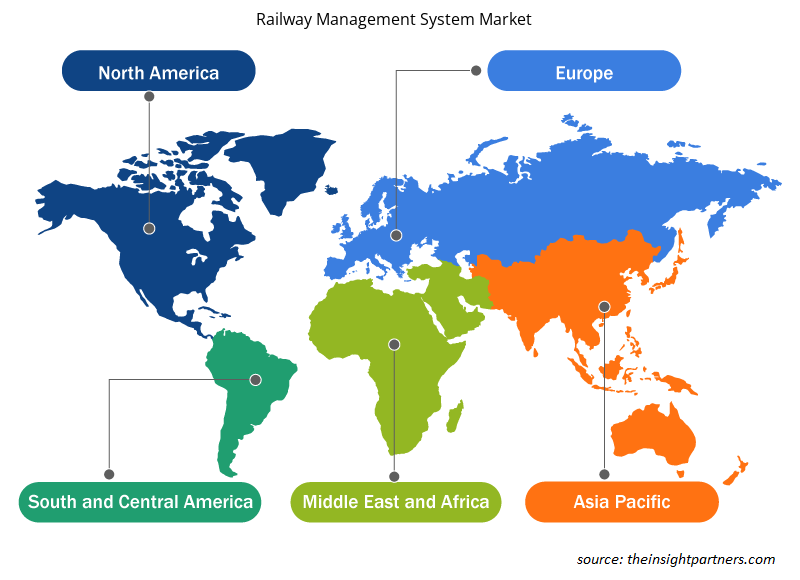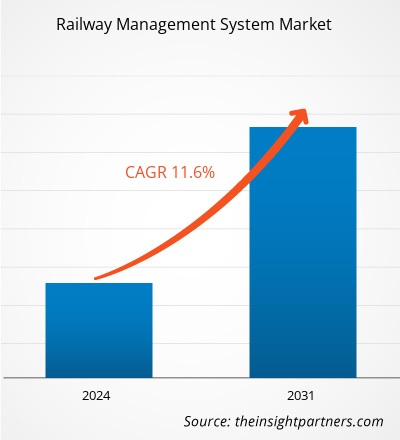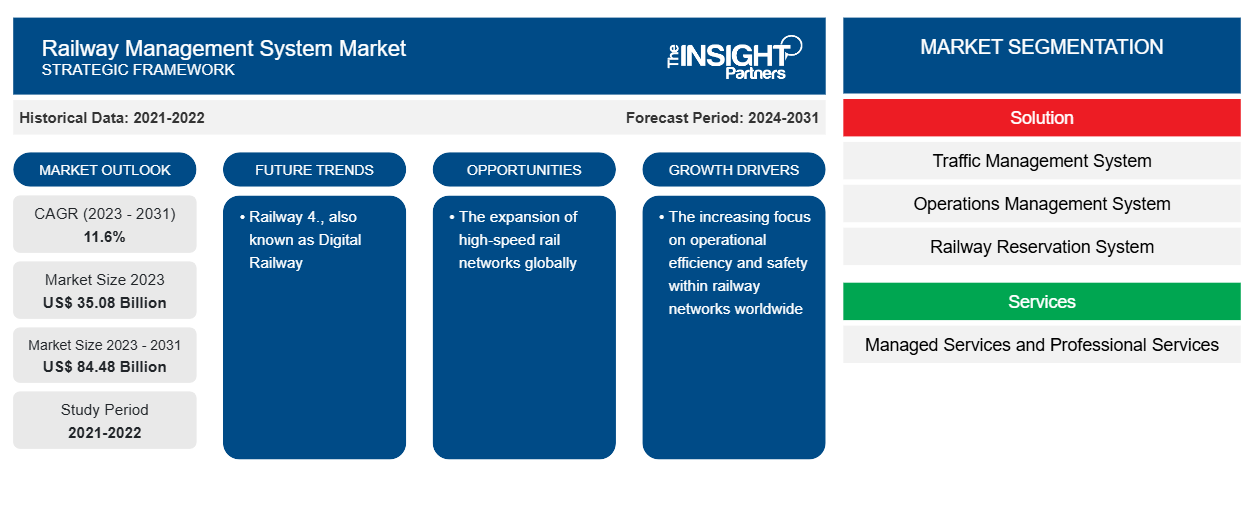Der Markt für Eisenbahnmanagementsysteme soll von 35,08 Milliarden US-Dollar im Jahr 2023 auf 84,48 Milliarden US-Dollar im Jahr 2031 anwachsen. Der Markt soll zwischen 2023 und 2031 eine durchschnittliche jährliche Wachstumsrate (CAGR) von 11,6 % verzeichnen. Railway 4.0, auch bekannt als Digital Railway, wird voraussichtlich weiterhin ein wichtiger Markttrend für Eisenbahnmanagementsysteme bleiben.
Marktanalyse für Eisenbahnmanagementsysteme
Der Markt für Eisenbahnmanagementsysteme wächst aufgrund verschiedener Trends in der Infrastrukturentwicklung und der Transporttechnologie. Diese Systeme konzentrieren sich auf Betriebseffizienz, verbesserte Sicherheit und Fahrgasterlebnis durch Funktionen wie Echtzeitüberwachung und vorausschauende Wartung. Mehrere Technologien treiben den Markt an, darunter KI (künstliche Intelligenz), IoT (Internet der Dinge) und Cloud-Computing, die eine Fernoptimierung und -verwaltung des Eisenbahnbetriebs ermöglichen. Insgesamt wächst und expandiert der Markt für Eisenbahnmanagementsysteme weltweit, angetrieben von der Notwendigkeit, die Effizienz, Sicherheit und Nachhaltigkeit der Eisenbahn zu verbessern.
Marktübersicht für Eisenbahnmanagementsysteme
Ein Eisenbahnmanagementsystem umfasst mehrere Prozesse und Technologien zur effizienten Verwaltung und zum Betrieb von Eisenbahnnetzen. Es umfasst Komponenten wie Frachtmanagement, Ticketsysteme , Fahrgastinformationen, Zugfahrpläne, Wartungsplanung und Sicherheitsüberwachung. Das System nutzt fortschrittliche Technologien wie GPS, Kommunikationsnetzwerke und IoT-Sensoren, um eine optimierte Routenplanung, die Gewährleistung der Sicherheit und die Echtzeitverfolgung von Zügen zu ermöglichen. Der Fahrgastservice wird durch Sitzplatzreservierung, Online-Ticketbuchung und Echtzeit-Updates der Zugfahrpläne verbessert. Darüber hinaus werden Wartungsaktivitäten rationalisiert und Ausfallzeiten reduziert sowie die allgemeine Betriebseffizienz durch den Einsatz von Techniken zur vorausschauenden Wartung verbessert.
Passen Sie diesen Bericht Ihren Anforderungen an
Sie erhalten kostenlose Anpassungen an jedem Bericht, einschließlich Teilen dieses Berichts oder einer Analyse auf Länderebene, eines Excel-Datenpakets sowie tolle Angebote und Rabatte für Start-ups und Universitäten.
-
Holen Sie sich die wichtigsten Markttrends aus diesem Bericht.Dieses KOSTENLOSE Beispiel umfasst eine Datenanalyse von Markttrends bis hin zu Schätzungen und Prognosen.
Markttreiber und Chancen für Eisenbahnmanagementsysteme
Der zunehmende Fokus auf Betriebseffizienz und Sicherheit in Eisenbahnnetzen weltweit
Angesichts des wachsenden Passagier- und Frachtaufkommens greifen Bahnbetreiber auf fortschrittliche Managementsysteme zurück, um Zugfahrpläne, Gleiswartung und die Gesamtleistung des Netzes zu optimieren. Diese Systeme nutzen Technologien wie IoT-Sensoren, prädiktive Analysen und Echtzeitüberwachung, um die Sicherheit zu erhöhen, Verspätungen zu minimieren und Betriebskosten zu senken. Durch die Verbesserung von Effizienz und Zuverlässigkeit tragen Bahnmanagementsysteme dazu bei, die steigenden Kundenerwartungen und gesetzlichen Standards zu erfüllen.IoT sensors, predictive analytics, and real-time monitoring to enhance safety, minimize delays, and reduce operational costs. By improving efficiency and reliability, railway management systems help meet rising customer expectations and regulatory standards.
Der Ausbau der Hochgeschwindigkeitsnetze weltweit
Viele Länder investieren in die Modernisierung ihrer Schieneninfrastruktur, um Hochgeschwindigkeitszüge zu unterstützen und schnellere und nachhaltigere Transportmöglichkeiten anzubieten. Dieser Trend schafft eine erhebliche Nachfrage nach fortschrittlichen Eisenbahnmanagementlösungen, die in der Lage sind, komplexe Abläufe bei höheren Geschwindigkeiten zu verwalten und eine nahtlose Konnektivität zwischen verschiedenen Schienennetzen sicherzustellen. Da Hochgeschwindigkeitsbahnprojekte weiter ausgebaut werden, steht der Markt für innovative Eisenbahnmanagementsysteme vor einem erheblichen Wachstum. Daher wird erwartet, dass der Ausbau der Hochgeschwindigkeitsbahnnetze weltweit den Akteuren auf dem Markt für Eisenbahnmanagementsysteme im Prognosezeitraum neue Möglichkeiten bietet.
Segmentierungsanalyse des Marktberichts zum Eisenbahnmanagementsystem
Wichtige Segmente, die zur Ableitung der Marktanalyse für Eisenbahnmanagementsysteme beigetragen haben, sind Lösung und Bereitstellungstyp.
- Basierend auf der Lösung ist der Markt für Eisenbahnmanagementsysteme in Verkehrsmanagementsysteme, Betriebsmanagementsysteme, Eisenbahnreservierungssysteme, Fahrgastinformationssysteme, Wartungsmanagementsysteme und andere unterteilt.
- Basierend auf den Diensten ist der Markt für Eisenbahnmanagementsysteme in Managed Services und Professional Services segmentiert.
- Nach Bereitstellungstyp ist der Markt in On-Premise und Cloud segmentiert. Das Cloud-Segment hatte im Jahr 2023 einen größeren Marktanteil.
Marktanteilsanalyse für Eisenbahnmanagementsysteme nach Geografie
Der geografische Umfang des Marktberichts zum Eisenbahnmanagementsystem ist hauptsächlich in fünf Regionen unterteilt: Nordamerika, Asien-Pazifik, Europa, Naher Osten und Afrika sowie Südamerika/Süd- und Mittelamerika. In Bezug auf den Umsatz hatte Europa den größten Marktanteil im Bereich Eisenbahnmanagementsysteme. In Europa treiben etablierte Eisenbahnnetze und ein Fokus auf Effizienz die Nachfrage nach fortschrittlichen Managementsystemen voran, die Sicherheit, Pünktlichkeit und das Fahrgasterlebnis verbessern. Länder wie Deutschland und Frankreich sind führend bei der Einführung modernster Technologien für Zugsteuerung, Signalisierung und Wartung.
Regionale Einblicke in den Markt für Eisenbahnmanagementsysteme
Die regionalen Trends und Faktoren, die den Markt für Eisenbahnmanagementsysteme im Prognosezeitraum beeinflussen, wurden von den Analysten von Insight Partners ausführlich erläutert. In diesem Abschnitt werden auch die Marktsegmente und die Geografie von Eisenbahnmanagementsystemen in Nordamerika, Europa, im asiatisch-pazifischen Raum, im Nahen Osten und Afrika sowie in Süd- und Mittelamerika erörtert.

- Get the Regional Specific Data for Railway Management System Market
Railway Management System Market Report Scope
| Report Attribute | Details |
|---|---|
| Market size in 2023 | US$ 35.08 Billion |
| Market Size by 2031 | US$ 84.48 Billion |
| Global CAGR (2023 - 2031) | 11.6% |
| Historical Data | 2021-2022 |
| Forecast period | 2024-2031 |
| Segments Covered |
By Solution
|
| Regions and Countries Covered |
North America
|
| Market leaders and key company profiles |
|
Railway Management System Market Players Density: Understanding Its Impact on Business Dynamics
The Railway Management System Market market is growing rapidly, driven by increasing end-user demand due to factors such as evolving consumer preferences, technological advancements, and greater awareness of the product's benefits. As demand rises, businesses are expanding their offerings, innovating to meet consumer needs, and capitalizing on emerging trends, which further fuels market growth.
Market players density refers to the distribution of firms or companies operating within a particular market or industry. It indicates how many competitors (market players) are present in a given market space relative to its size or total market value.
Major Companies operating in the Railway Management System Market are:
- Bombardier, Inc.
- DXC Technology Company
- EKE-Electronics Ltd
- General Electric Company
- Hitachi, Ltd.
- Huawei Technologies Co.; Ltd.
Disclaimer: The companies listed above are not ranked in any particular order.

- Get the Railway Management System Market top key players overview
Railway Management System Market News and Recent Developments
The railway management system market is evaluated by gathering qualitative and quantitative data post primary and secondary research, which includes important corporate publications, association data, and databases. The following is a list of developments in the market for speech and language disorders and strategies:
- In August 2023, Toast, the all-in-one technology platform built for restaurants, announced the launch of Toast Catering & Events, a new product fully integrated with the Toast point-of-sale (POS) to help restaurants seamlessly manage large catering orders and event planning. Toast Catering & Events supports customizable banquet event orders (BEO), fulfillment tools, and lead management functionality. (Source: Toast, Press Release)
- Im Juni 2021 kündigte FoodStorm, der weltweit führende Anbieter von Catering-Software, die Einführung seines FoodStorm Kiosk an, eines physischen Selbstbedienungskiosks, an dem Kunden im Geschäft Catering, Fertiggerichte, Feinkost und Backwaren über ein verwaltetes Backend bestellen können. (Quelle: FoodStorm, Pressemitteilung)
Marktbericht zum Eisenbahnmanagementsystem – Umfang und Ergebnisse
Der Bericht „Marktgröße und Prognose für Eisenbahnmanagementsysteme (2023–2031)“ bietet eine detaillierte Analyse des Marktes, die die folgenden Bereiche abdeckt:
- Marktgröße und Prognose auf globaler, regionaler und Länderebene für alle wichtigen Marktsegmente, die im Rahmen des Projekts abgedeckt sind
- Marktdynamik wie Treiber, Beschränkungen und wichtige Chancen
- Wichtige Zukunftstrends
- Detaillierte PEST/Porters Five Forces- und SWOT-Analyse
- Globale und regionale Marktanalyse mit wichtigen Markttrends, wichtigen Akteuren, Vorschriften und aktuellen Marktentwicklungen
- Branchenlandschaft und Wettbewerbsanalyse, einschließlich Marktkonzentration, Heatmap-Analyse, prominenten Akteuren und aktuellen Entwicklungen
- Detaillierte Firmenprofile
- Historische Analyse (2 Jahre), Basisjahr, Prognose (7 Jahre) mit CAGR
- PEST- und SWOT-Analyse
- Marktgröße Wert/Volumen – Global, Regional, Land
- Branchen- und Wettbewerbslandschaft
- Excel-Datensatz
Aktuelle Berichte
Verwandte Berichte
Erfahrungsberichte
Grund zum Kauf
- Fundierte Entscheidungsfindung
- Marktdynamik verstehen
- Wettbewerbsanalyse
- Kundeneinblicke
- Marktprognosen
- Risikominimierung
- Strategische Planung
- Investitionsbegründung
- Identifizierung neuer Märkte
- Verbesserung von Marketingstrategien
- Steigerung der Betriebseffizienz
- Anpassung an regulatorische Trends























 Kostenlose Probe anfordern für - Markt für Eisenbahnmanagementsysteme
Kostenlose Probe anfordern für - Markt für Eisenbahnmanagementsysteme